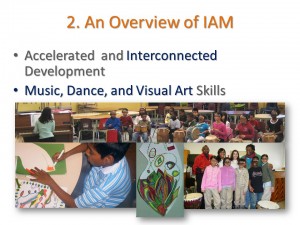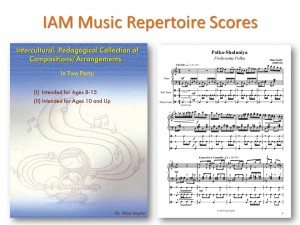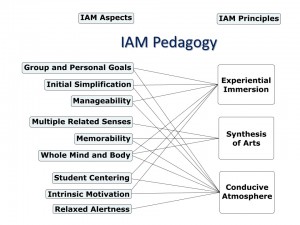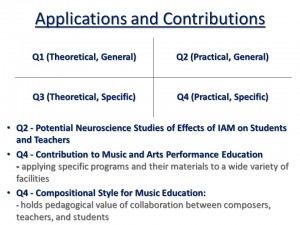 Integrated Arts Method (IAM) Ⓡ – Introduction (Scroll Down for Music Resources)
Integrated Arts Method (IAM) Ⓡ – Introduction (Scroll Down for Music Resources)
IAM is an acronym for Integrated Arts Method, which is an alternate experiential, integrated, conducive, and student-centered music and arts pedagogical method that can facilitate effective teaching for effective learning. IAM is an original teaching and learning method that Nina Soyfer developed, tested, and introduced before and during her doctoral studies (2007-2016). It is clearly outlined in her doctoral dissertation titled “Integrated Arts” Pedagogy and Philosophy.
IAM’s three key principles of effective teaching for effective learning are: 1) physical experience based, 2) with synthesis of related subjects, and 3) taught in a positive and stimulating atmosphere.
Accurate facilitation of these key principles involves techniques, aspects, and pedagogical attitudes which are specified and explained in her doctoral dissertation (link to the full pdf is http://yorkspace.library.yorku.ca/xmlui/handle/10315/32252). IAM pedagogy is embodied through a set of general principles, specific attitudes, and practical tools for achieving required emotional, mental, physiological, and psychological functioning of both learner and teacher for their mutual effectiveness. Results of real world IAM programs in subject areas of music and arts suggest that the pedagogy of IAM contributes to effective, enjoyable, and memorable education. Explanation and support of this contribution stem from scientific, educational, sociological, philosophical, neuroscience, cognition, and music and arts literature.
Three key philosophical principles and a number of general techniques and attitudes are suggested as contributing factors to observed success of IAM. These generalized contributing factors, the IAM pedagogy and philosophy, are comparable with existing related pedagogical methods, which offer indirect explanation and support for the success of IAM. In turn, these pedagogical principles and attitudes allow generalization of IAM’s advantages to other subject areas. IAM pedagogy contributes to the field of education generally, and arts education specifically, with original music and interdisciplinary programs, materials, compositions, and procedures, which represent practical and effective tools for both educators’ and students’ success.
The applications and contributions of this research and method are summarized in the image below (click here to read in detail) thus offering it to researchers in education, psychology, and sciences, as well as to general reader, and teachers in arts and beyond.
Academic Resources:
Defense Presentation (Summarizing the Method, contributions, applications, and comparing to other methods)
Music Resources for IAM Teachers:
Practice Tracks for IAM Sample Repertoire (Click Here)

Selected Video Bibliography:
Arguelles, Lourdes, Rollin McCraty and Robert A. Rees. 2003. “The Heart in Holistic Education.” In Encounter: Education for Meaning and Social Justice, vol. 16, no. 3, pp. 13-21. http://www.heartmath.org/templates/ihm/downloads/pdf/research/publications/heart-in-education.pdf (accessed April 11, 2014).
Caine, Renate Nummela and Geoffrey Caine. 1990. “Understanding a Brain-Based Approach to Learning and Teaching.” In Educational Leadership, vol. 48, no. 2: pp. 66-70. http://www.ascd.org/ASCD/pdf/journals/ed_lead/el_199010_caine.pdf (accessed October 6, 2014).
Goswami, Usha. 2008. “Principles of Learning, Implications for Teaching: A Cognitive Neuroscience Perspective.” In Journal of Philosophy of Education, vol. 42, nos. 3-4, pp. 381–399. http://onlinelibrary.wiley.com/doi/10.1111/j.1467-9752.2008.00639.x/pdf (accessed February 1, 2015).
Jones, Timothy B., ed. 2013. Education for the Human Brain: A Road Map to Natural Learning in Schools. Plymouth, UK: Rowman & Littlefield Publishers, Inc.
Lozanov, Georgi. 1978. Suggestology and Outlines of Suggestopedy. New York: Gordon and Breach Science Publishers Inc.
Meier, David. 2014. The Center for Accelerated Learning: What is Accelerated Learning. http://www.alcenter.com/what_is.php (accessed April 28, 2014).
Ozden, Muhammet, and Mehmet Gultekin. 2008. “The Effects of Brain-Based Learning on Academic Achievement and Retention of Knowledge in Science Course.” In Electronic Journal of Science Education, vol. 12, no.1. Southwestern University. http://ejse.southwestern.edu/article/view/7763/5530 (accessed October 6, 2014).
Rose, Colin. 1987. Accelerated Learning. New York: Dell Publishing.
Schutz, Paul and Reinhard Pekrun, ed. 2007. Emotion in Education. London: Academic Press.
Soyfer, Nina. 2016. “Integrated Arts Pedagogy and Philosophy.” Canada: York University. http://yorkspace.library.yorku.ca/xmlui/handle/10315/32252 (accessed January 12, 2017).
Sweller, John, Jeroen J. G. van Merrienboer, and Fred G. W. C. Paas. 1998. “Cognitive Architecture and Instructional Design.” In Educational Psychology Review, vol. 10. No. 3, pp. 251-296.
While it is encouraged to explore IAM in your teacher practice, please note that in order to be referring to yourself as an IAM teacher/practitioner and accurately employing the Integrated Arts Method appropriate certification from Nina Soyfer must be received first (please contact Nina Soyfer using the contact form below).
[contact-form]



